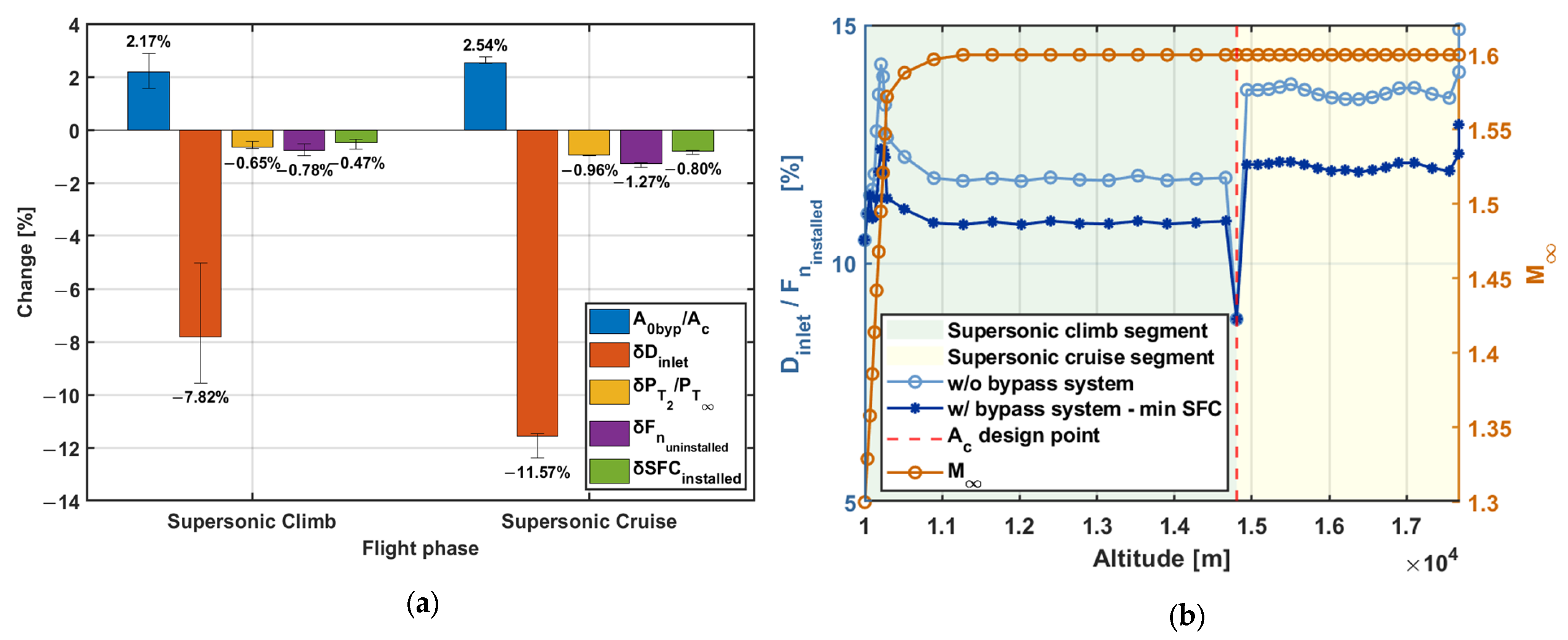Installation Effects of Supersonic Inlets on Next-Generation SST Turbofan Engines †
Abstract
1. Introduction
2. Methodology
2.1. Thrust/Drag Bookkeeping
2.2. Integrated Framework
2.3. Supersonic Inlet Model
2.3.1. Supersonic Inlet Performance Characterization and Inlet/Engine Flow Matching
2.3.2. Capture Area Sizing
2.3.3. Operating Constraints
3. Case Study
4. Results
5. Conclusions
Author Contributions
Funding
Institutional Review Board Statement
Informed Consent Statement
Data Availability Statement
Conflicts of Interest
Nomenclature
| Inlet capture area | |
| Equivalent freestream tube area of the inlet airflow demand including the boundary-layer bleed requirements | |
| Equivalent freestream tube area of the inlet airflow demand passing through the inlet throat | |
| Equivalent freestream tube area of the engine airflow demand | |
| Equivalent freestream tube area of the spilled airflow | |
| Equivalent freestream tube area of the boundary-layer bleed airflow | |
| Equivalent freestream tube area of the bypassed airflow | |
| Total inlet drag coefficient normalized on the capture area | |
| Spillage drag coefficient normalized on the capture area | |
| Bleed drag coefficient normalized on the capture area | |
| Bypass drag coefficient normalized on the capture area | |
| Total inlet drag force | |
| Total afterbody drag force | |
| Uninstalled net thrust force | |
| Installed net thrust force | |
| Freestream Mach number | |
| Inlet total pressure recovery | |
| Installed specific fuel consumption | |
| Freestream velocity | |
| Freestream air density |
References
- International Civil Aviation Organization. Available online: https://www.icao.int/environmental-protection/pages/Supersonic-Aircraft-Noise-Standards-Development.aspx (accessed on 25 November 2024).
- Boom Supersonic. Available online: https://boomsupersonic.com/overture (accessed on 25 November 2024).
- NASA. Available online: https://www.nasa.gov/mission/quesst/ (accessed on 25 November 2024).
- Wedge, H.R.; Bonet, J.; Magee, T.; Chen, D.; Hollowell, S.; Kutzmann, A.; Mortlock, A.; Stengle, J.; Nelson, C.; Adamson, E.; et al. N+2 Supersonic Concept Development and Systems Integration. NASA/CR–2010-216842. 1 August 2010. Available online: https://ntrs.nasa.gov/api/citations/20100030607/downloads/20100030607.pdf (accessed on 25 November 2024).
- Welge, H.R.; Bonet, J.; Magee, T.; Tompkins, D.; Britt, T.R.; Nelson, C.; Miller, G.; Stenson, D.; Staubach, J.B.; Bala, N.; et al. N+3 Advanced Concept Studies for Supersonic Commercial Transport Aircraft Entering Service in the 2030–2035 Period. NASA/CR–2011-217084. 1 April 2011. Available online: https://ntrs.nasa.gov/api/citations/20110010973/downloads/20110010973.pdf (accessed on 25 November 2024).
- SENECA Project. Available online: https://seneca-project.eu/ (accessed on 25 November 2024).
- Del Gatto, D.; Adamidis, S.; Mourouzidis, C.; Brown, S.; Pachidis, V. Design space exploration of next-generation supersonic business jet engine with a focus on Landing and Take-Off (LTO) noise. In Proceedings of the ICAS 2024, Stresa, Italy, 8–12 September 2024; International Council of the Aeronautical Sciences: Florence, Italy, 2024. [Google Scholar]
- Berton, J.; Haller, W. A Comparative Propulsion System Analysis for the High-Speed Civil Transport. NASA/TM-2005-213414. 1 February 2005. Available online: https://ntrs.nasa.gov/api/citations/20050123580/downloads/20050123580.pdf (accessed on 25 November 2024).
- Villena, M.C.; Lawson, C.; Riaz, A.; Jaron, R. Conceptual Design of Supersonic Aircraft to Investigate Environmental Impact. In Proceedings of the AIAA SciTech 2024 Forum, Orlando, FL, USA, 8–12 January 2024. [Google Scholar]
- Smith, H.; Sun, Y. Design case of the E-19 AEOLUS supersonic business jet. In Proceedings of the AIAA Aviation 2020 Forum, Virtual event, 15–19 June 2020. [Google Scholar]
- Ball, W.H.; Hickcox, T.E. Rapid Evaluation of Propulsion System Effects—Volume 2; AFFDL-TR-78-91; Air Force Flight Dynamics Laboratory: Montgomery, OH, USA, 1978. [Google Scholar]
- Mourouzidis, C.; Del Gatto, D.; Adamidis, S.; Munoz, C.V.; Lawson, C.; Corzo, B.M.; Leyland, P.; Marsh, D.; Lim, L.; Owen, B.; et al. Preliminary Design of Next Generation Mach 1.6 Supersonic Business Jets to Investigate Landing & Take-Off (LTO) Noise and Emissions—SENECA. J. Phys. Conf. Ser. 2023, 2526, 012011. [Google Scholar]
- Kowalski, E.J. Computer Code for Estimating Installed Performance of Aircraft Gas Turbine Engines—Volume 1. NASA/CR-159691. 1 December 1979. Available online: https://ntrs.nasa.gov/citations/19800004788 (accessed on 25 November 2024).
- Slater, J.W. SUPIN: A Computational Tool for Supersonic Inlet Design. AIAA 2016-0530. In Proceedings of the 54th AIAA Aerospace Sciences Meeting, San Diego, CA, USA, 4–8 January 2016. [Google Scholar]
- Chima, R.V. Analysis of Buzz in a Supersonic Inlet. NASA/TM–2012-217612. 1 May 2012. Available online: https://ntrs.nasa.gov/api/citations/20120009203/downloads/20120009203.pdf (accessed on 25 November 2024).
- Kowalski, E.J.; Atkins, R., Jr. Computer Code for Estimating Installed Performance of Aircraft Gas Turbine Engines—Volume 3. NASA/CR-159693. 1 December 1979. Available online: https://ntrs.nasa.gov/citations/19800004790 (accessed on 25 November 2024).




Disclaimer/Publisher’s Note: The statements, opinions and data contained in all publications are solely those of the individual author(s) and contributor(s) and not of MDPI and/or the editor(s). MDPI and/or the editor(s) disclaim responsibility for any injury to people or property resulting from any ideas, methods, instructions or products referred to in the content. |
© 2025 by the authors. Licensee MDPI, Basel, Switzerland. This article is an open access article distributed under the terms and conditions of the Creative Commons Attribution (CC BY) license (https://creativecommons.org/licenses/by/4.0/).
Share and Cite
Adamidis, S.; Gatto, D.D.; Mourouzidis, C.; Brown, S.; Pachidis, V. Installation Effects of Supersonic Inlets on Next-Generation SST Turbofan Engines. Eng. Proc. 2025, 90, 50. https://doi.org/10.3390/engproc2025090050
Adamidis S, Gatto DD, Mourouzidis C, Brown S, Pachidis V. Installation Effects of Supersonic Inlets on Next-Generation SST Turbofan Engines. Engineering Proceedings. 2025; 90(1):50. https://doi.org/10.3390/engproc2025090050
Chicago/Turabian StyleAdamidis, Stylianos, Dario Del Gatto, Christos Mourouzidis, Stephen Brown, and Vassilios Pachidis. 2025. "Installation Effects of Supersonic Inlets on Next-Generation SST Turbofan Engines" Engineering Proceedings 90, no. 1: 50. https://doi.org/10.3390/engproc2025090050
APA StyleAdamidis, S., Gatto, D. D., Mourouzidis, C., Brown, S., & Pachidis, V. (2025). Installation Effects of Supersonic Inlets on Next-Generation SST Turbofan Engines. Engineering Proceedings, 90(1), 50. https://doi.org/10.3390/engproc2025090050





